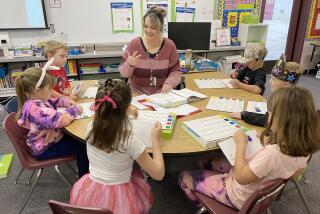U.S. Student Survey Paints Bleak Picture of Writing Abilities
- Share via
Public school students throughout the United States write very poorly, and students in Catholic schools do only slightly better, a prominent educational official said Tuesday in Anaheim.
Archie Lapointe, executive director of the National Assessment of Educational Progress, or NAEP, in Princeton, N.J., provided the first details of a report that will become the third major study in less than a year to offer a gloomy assessment of the abilities of U. S. students,
“American students . . . don’t write well,” Lapointe told the National Catholic Educators Assn. convention at the Anaheim Hilton Hotel. He warned the educators that an NAEP survey to be made public April 12 will contain “bad news” about students’ writing ability.
The survey will complement a report on students’ reading ability that was released last September. According to that report, only 45% of white 17-year-old students surveyed had the ability to read and understand relatively complicated information. Among black students, only 18% could read and understand complicated information, and only 20% of Latino students could handle such reading, the survey found.
In noting that Catholic school students do better in reading at all age levels than their public school counterparts, the report said that Catholic school students are assigned more homework and also tend to watch less television.
American students also do very badly in mathematics, according to an international survey released last month. That survey, unlike the NAEP analyses of only American students, compared students from 17 countries. It found that American students did so poorly in math that they could only outperform students from Third World countries.
Funds From Congress
The NAEP receives funds from the U. S. Department of Education and is run by the Educational Testing Service, the same private company that administers the national Scholastic Aptitude Tests. Congress began providing funds for NAEP 17 years ago to help the nation learn how well--or how poorly--education was faring in the United States.
Speaking Tuesday of the soon-to-be released report on writing ability, Lapointe said: “We’re arguing among ourselves (at the testing service) these last few days whether we should say ‘disappointingly so’ or ‘distressingly so.’ But regardless of what adverb we put in front of that, (the test results are) going to be bad news.
“You’re all going to be disappointed when you see it (the data).” Lapointe offered few statistics, but did disclose the following:
- “The basics are doing well: kids spell better and their grammar is better.” Lapointe said the test results indicate that spelling and grammar are improving because “75% of the students say their teachers are correcting their papers for spelling and grammar.”
- Teachers throughout the nation are not giving as much attention to “the quality of ideas” in students’ written assignments. Lapointe said that less than a third of the students tested nationally said that their teachers “discuss the quality of ideas or ask them to rewrite certain portions to make something clear.”
- While Catholic school students are doing better than their public school counterparts in writing, the difference is slight--not nearly as marked as the difference in Catholic students’ reading ability over public school students.
Catholic schools did well in the NAEP survey of students’ reading ability. The survey found that Catholic school students’ reading ability was “considerably higher than the national average,” and that minority students in Catholic schools did much better than their counterparts in public schools throughout the nation.
Can’t Be Compared
In an interview after his talk Tuesday, Lapointe acknowledged that differences in enrollment between public and Catholic schools do not make for comparison of equals.
“They’re different,” he said. “A kid who gets kicked out of Catholic school for discipline problems ends up in public school. . . . You can’t compare those two groups. That’s a valid question.
“On the other hand,” Lapointe said, “to the extent that the environment in the Catholic schools is different from the environment in the public schools, there may be some things the public schools can learn from observing.”
More to Read
Sign up for Essential California
The most important California stories and recommendations in your inbox every morning.
You may occasionally receive promotional content from the Los Angeles Times.













